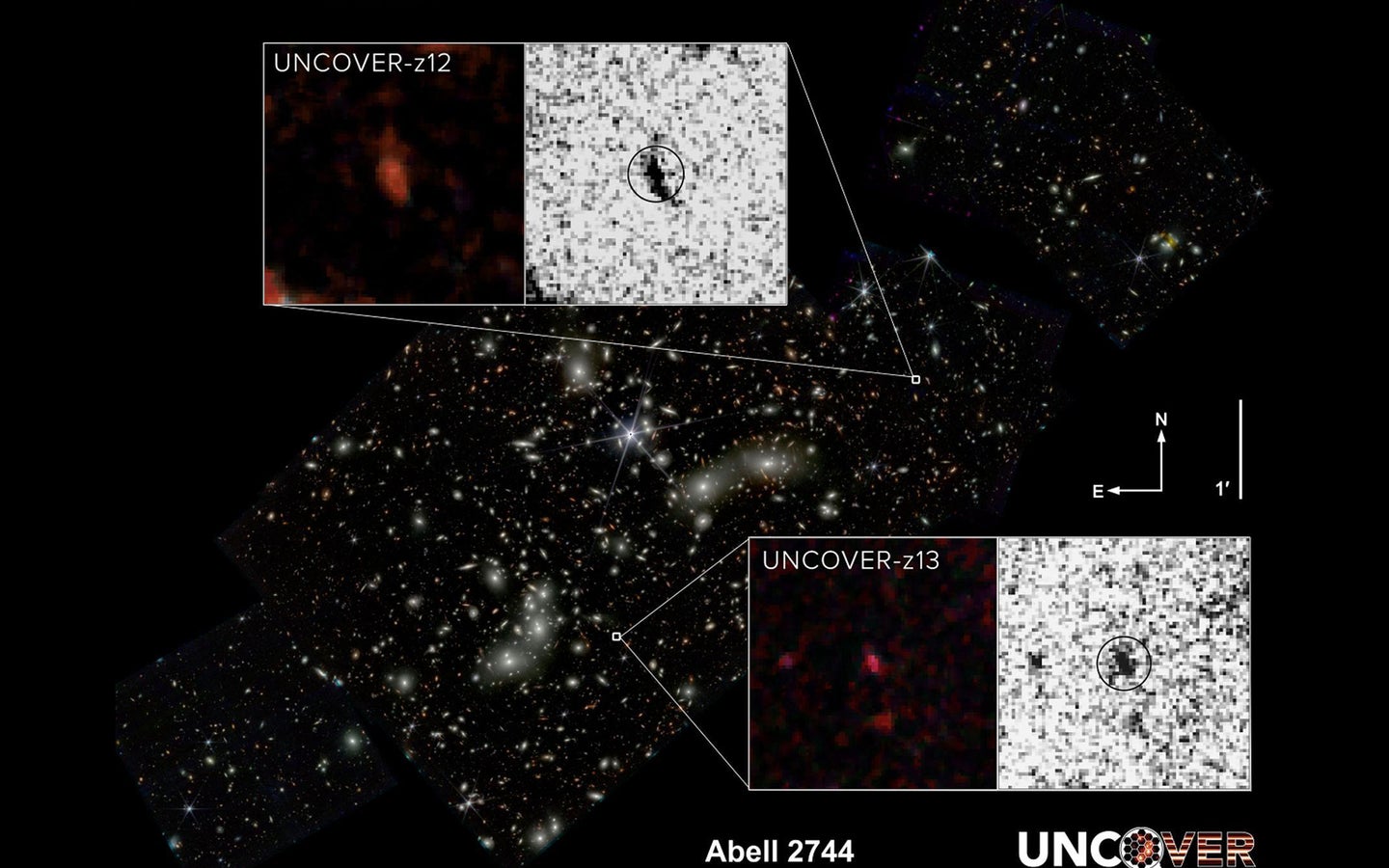JWST spots two of the most distant galaxies astronomers have ever seen
The data on UNCOVER z-13 and UNCOVER z-12 helps support the Big Bang theory.

A team using NASA’s James Webb Space Telescope has observed two of the most distant galaxies astronomers have ever seen. At close to 33 billion light years away from Earth, these distant regions can offer insight into how the universe’s earliest galaxies may have formed. The findings are detailed in a study published November 13 in The Astrophysical Journal Letters.
[Related: ‘Christmas tree’ galaxy shines in new image from Hubble and JWST.]
The galaxies UNCOVER z-13 and UNCOVER z-12 are the second and fourth most distant galaxies ever observed and are located in a region called Pandora’s Cluster (Abell 2744). The two galaxies are among the 60,000 sources of light in Pandora’s Cluster that were captured in some of the first deep field images the JWST took in 2022. This region of space was selected for this kind of imaging due to its location behind several galaxy clusters. The light creates a natural magnification effect called gravitational lensing. This happens when the gravitational pull of the clusters’ combined mass warps the space-time around it. It then magnifies any light that passes nearby and offers a larger view behind the clusters.
Other galaxies confirmed at this distance generally appear in images as red dots. However, these new galaxies are larger and look more like a peanut and a fluffy ball, according to the team.
“Very little is known about the early universe, and the only way to learn about that time and to test our theories of early galaxy formation and growth is with these very distant galaxies,” study co-author and astronomer Bingjie Wang from Penn State University said in a statement. “Prior to our analysis, we knew of only three galaxies confirmed at around this extreme distance. Studying these new galaxies and their properties has revealed the diversity of galaxies in the early universe and how much there is to be learned from them.”
Wang is also a member of the JWST UNCOVER (Ultradeep NIRSpec and NIRCam ObserVations before the Epoch of Reionization) team that conducted this research. UNCOVER’s early goal is to obtain highly detailed images of the region around Pandora’s Cluster using JWST.
Since the light that is emitted from these galaxies had to travel for so long to reach Earth, it offers a window into the universe’s past. The team estimates that the light JWST detected was emitted by the two galaxies when the universe was about 330 million years old and that it traveled for about 13.4 billion light years to reach the space telescopes.
However, the galaxies are currently closer to 33 billion light years away from Earth because of the expansion of the universe over this period of time.
“The light from these galaxies is ancient, about three times older than the Earth,” study co-author, Penn State astronomer, and UNCOVER member Joel Leja said in a statement. “These early galaxies are like beacons, with light bursting through the very thin hydrogen gas that made up the early universe. It is only by their light that we can begin to understand the exotic physics that governed the galaxy near the cosmic dawn.”
[Related: JWST takes a jab at the mystery of the universe’s expansion rate.]
The two galaxies are also considerably bigger than the three galaxies previously located at these extreme distances. While our Milky Way galaxy is roughly 100,000 light years across, galaxies in the early universe are believed to have been very compressed. A galaxy of 2,000 light years across like one of ones the team imaged came as a surprise.
“Previously discovered galaxies at these distances are point sources—they appear as a dot in our images,” Wang said. “But one of ours appears elongated, almost like a peanut, and the other looks like a fluffy ball. It is unclear if the difference in size is due to how the stars formed or what happened to them after they formed, but the diversity in the galaxy properties is really interesting. These early galaxies are expected to have formed out of similar materials, but already they are showing signs of being very different than one another.”
To make inferences about these early galaxies, the team used detailed models. They believed that in addition to being young (by space standards), the two galaxies also had few metals in their composition, and were growing rapidly and actively forming stars.
“The first elements were forged in the cores of early stars through the process of fusion,” Leja said. “It makes sense that these early galaxies don’t have heavy elements like metals because they were some of the first factories to build those heavy elements. And, of course, they would have to be young and star-forming to be the first galaxies, but confirming these properties is an important basic test of our models and helps confirm the whole paradigm of the Big Bang theory.”
Astronomers will continue to use lensing clusters and the instruments aboard the JWST to continue to peel back the timeline of some of the universe’s first galaxies.